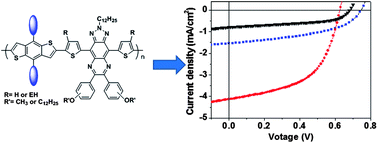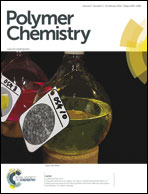Design and synthesis of triazoloquinoxaline polymers with positioning alkyl or alkoxyl chains for organic photovoltaics cells†
Abstract
Four benzodithiophene-triazoloquinoxaline alternating polymers, PBDTT-BTzQx-EH-C1, PBDT-BTzQx-EH-C1, PBDT-BTzQx-EH-C12 and PBDT-BTzQx-C12, have been designed and synthesized to investigate the correlation of alkyl side chains with the opto-electronic properties of the resulting polymers. The introduction of side chains onto the thiophene spacer or quinoxaline unit lowers the highest occupied molecular orbital energy level of the polymers, while excessive chains prevent the polymer backbone from π–π stacking and result in a decreased short circuit current and fill factor in a photovoltaic application. The bulk heterojunction cells fabricated by blending PBDTT-BTzQx-EH-C1 with [6,6]-phenyl-C61-butyric acid methyl ester exhibit a best power conversion efficiency (PCE) of 1.40%, with a short-circuit current density of 4.12 mA cm−2, an open-circuit voltage of 0.62 V and a fill factor of 55%. The device was further optimized to 2.24% PCE by using PFN (5 nm)/Ca (5 nm) as a co-interfacial layer.


 Please wait while we load your content...
Please wait while we load your content...